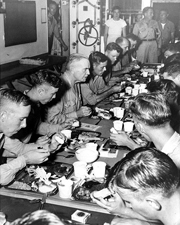New Jersey played a pivotal role in the cause winning and defending the freedom of the nation and its people. New Jersey witnessed more significant military action in the American Revolution than any other state, and its men and women have served honorably in every conflict since then. Safeguarding liberty also extends to guaranteeing citizens' rights, and New Jersey was the first state to ratify the Bill of Rights in 1789. To find a site from our collection of Sites noted for Liberty: Please click on the title to the right to view site. |
Index |
|---|
New Jersey—350 Years of Liberty |
||
 |
 |
Indian King Tavern, ca. 1732 Camden County, Haddonfield Borough State Historic Site National and State Registers of Historic Places |
After the British occupation of nearby Philadelphia in September 1777, Haddonfield exchanged hands between Crown and Rebel forces four times. Initially constructed about 1732 as a brewery, distillery, store, and dwelling, the structure was enlarged in 1741 and again circa 1764 before becoming a three-rental dwelling and, in 1777, a tavern. Renovated many times in the 19th century, in 1903, the Indian King Tavern became New Jersey’s first State-owned historic site. |
||
 |
 |
|
Indian King Tavern, 1901. |
Indian King Tavern. |
|
For more information on this site and subject, visit: https://www.nj.gov/dep/parksandforests/historic/indianking/index.html |
||
New Jersey - 350 years of Liberty |
||
 |
 |
Finn's Point National Cemetery 1875 Salem County, Pittsgrove Township National Cemetery, National and State Registers of Historic Places |
Finn's Point earned designation as a national cemetery in 1875, with a marble monument to the Union dead and a Superintendent's Lodge in the Second Empire style erected on the site soon after. In 1910, the Federal government honored the Confederate veterans buried at the site with an 85-foot granite obelisk and bronze panels listing their names. Also interred are American veterans through World War II, along with 13 deceased German POWs from Fort Dix in the 1940s. Finn's Point National Cemetery is adjacent to and accessible from Fort Mott |
||
|
 |
 |
| Confederate Monument, 1910 | Union Monument, circa 1875 |
Superintendent's Lodge , 1877 |
| All photos Courtesy U.S. Department of Veterans Affairs, National Cemetery Administration, History Program. |
||
| For more information on this site and subject, visit http://www.nps.gov/history/nr/travel/national_cemeteries/New_Jersey/Finns_Point_National_ Cemetery.html https://www.state.nj.us/dep/parksandforests/parks/fortmott.html or search the following terms: “Finn's Point National Cemetery” “Fort Mott State Park” “Fort Delaware” |
||
USS New Jersey
(BB-62)
Camden County, City of Camden
National and State Registers
of Historic Places
From the patriots of the American Revolution to the brave men and women serving today in our armed forces around the globe, New Jersey’s citizens have struggled and sacrificed to defend our liberties throughout the nation’s history. The USS New Jersey (BB-62), the most decorated battleship in U.S. naval history, is a powerful symbol of the strength and courage of the men and women of her namesake state.One of four Iowa class battleships built, construction of the New Jersey began at the Philadelphia Naval Shipyard in 1940. The ship was launched on December 7, 1942, exactly one year after the Japanese attack on Pearl Harbor and the United States' entrance into World War II. She began active combat duty in early 1944 and in August of that year became the flagship of Admiral William F. "Bull" Halsey, Jr., Commander of the Pacific Third Fleet and a native of New Jersey. The New Jersey and her crew served valiantly in many of the major campaigns in the Pacific Theatre of the war, earning a total of nine battle stars.
The New Jersey was decommissioned in 1948, but reentered active service in 1950 during the Korean Conflict and again in 1968—the only U.S. battleship recalled to active duty during the Vietnam War. The New Jersey was commissioned for a fourth and final time in 1982, seeing combat service during the Lebanese Civil War in 1983-1984. The ship was decommissioned for the final time in February 1991.
In November 1999, the New Jersey returned to the Philadelphia Naval Shipyard, where her story began almost 60 years earlier. A few months later, the Navy announced that the ship would be donated to the Home Port Alliance of Camden and opened to the public for use as an educational museum. Following an extensive restoration, the New Jersey made the short trip up the Delaware River to her new home along the Camden waterfront, where visitors may explore this incredible example of 20th-century naval technology, and learn about the role of the ship and its courageous sailors in defending our nation's freedom.
(Top Photograph) USS New Jersey's guns firing off the coast of Lebanon, 1984. Courtesy U.S. Department of Defense
Adm. WIlliam F. Halsey, Jr. dines with the crew 1944. Courtesy U.S. National Archives USS New Jersey on the Camden waterfront. Courtesy Home Port Alliance for the USS New Jersey For more information on this site and subject, visit http://www.battleshipnewjersey.org/
or search the following terms: “USS New Jersey” “Battleship New Jersey”
|
|
|
|
| |




